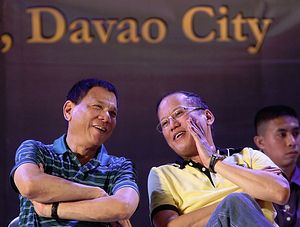Late last month, the administration of Philippine President Rodrigo Duterte submitted its first budget proposal to Congress. Though it still has to go through an approval process and we are just over two months into his six year term, it is worth taking a closer look to see what this tells us about his potential priorities in the defense realm.
Duterte has asked Congress for a 15 percent year-on-year increase in the country’s defense budget, taking it to 130.6 billion pesos ($2.9 billion). Those glancing at that figure alone might conclude that the Philippines is engaged in a major defense buildup. It is important to keep in mind, however, that the country currently has one of the weakest militaries in the Asia-Pacific following years of neglect in this realm, so it is in fact building from a low base and is rushing to catch up with some of its regional peers (See: “The Truth About Philippine Military Modernization and the China Threat”).
As with defense budgets more generally, the distribution of the budget among the services tells us much more than the total amount which often makes the headlines. Within the budget, the bulk of it is going to the Philippine Army ($1.2 billion), with the rest going to the Philippine Navy ($442 million) and the Philippine Air Force ($405 million).
The focus on the Army – as well as the significant, separate 25 percent budget boost for the Philippine National Police (PNP) – is in line with the administration’s priorities as well as its greater relative focus on internal rather than external threats, at least at the outset. As Budget Secretary Benjamin Diokno, who introduced the budget, said, the key focus was on boosting the administration’s triple wars against crime, illegal drugs and terrorism and insurgency.
That said, as much as this national budget was called “A Budget for Real Change,” it is important not to overstate the differences between this one and the ones prior to it. Though it is still early days, as an example of continuity, the Duterte administration looks set to continue the plans and funding amounts under the Armed Forces Modernization Act initiated in 2013. Under that plan, military modernization is divided into three “horizons” or phases – the first from now till 2017; the second from 2018 to 2023; and the third from 2024 to 2028 – with 83 billion pesos allocated for the first horizon.
As part of this first horizon, the Philippines is still set to spend 25 billion pesos for its military modernization efforts this year, similar to the amount spent last year. This includes funding for items already prioritized, such as fighter jets, helicopters, frigates, radars, and base upgrades. And all this is happening in spite of Duterte’s controversial suggestion back in June that money was being wasted on items like FA-50 jets from South Korea when the country was confronting more pressing internal security needs like resolving raging insurgencies in the south. That suggests, once again, that we ought to pay as much if not more attention to what the Philippines is doing rather than what Duterte is saying.

































